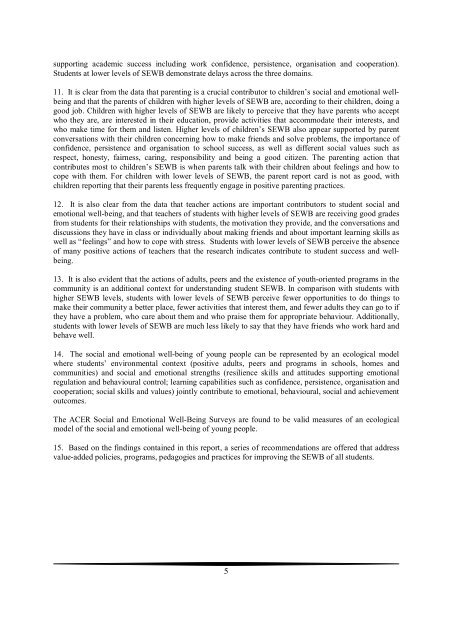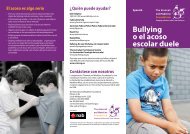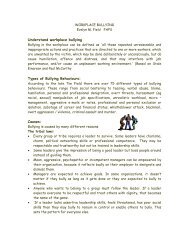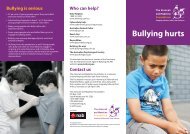SEWB are inclusive such that <strong>students</strong> at a higher level <strong>of</strong> SEWB are likely to display the positive <strong>social</strong><strong>and</strong> <strong>emotional</strong> characteristics <strong>of</strong> SEWB represented at lower levels.4. Students with lower levels <strong>of</strong> SEWB are likely to experience many negative emotions <strong>and</strong> behaviours(e.g. feeling down, stress, under-achievement, <strong>bully</strong>ing), as well as few positive emotions <strong>and</strong> behaviours(e.g. getting along with teachers, volunteering). <strong>The</strong>y are likely to demonstrate few <strong>social</strong> <strong>and</strong> <strong>emotional</strong>capabilities (low resilience, learning capabilities <strong>and</strong> <strong>social</strong> skills <strong>and</strong> values) as well as to perceive fewpositive actions <strong>of</strong> adults, peers <strong>and</strong> youth-oriented programs in their schools, homes <strong>and</strong> communities.Students with higher levels <strong>of</strong> SEWB are likely to experience fewer negative emotions <strong>and</strong> behaviours<strong>and</strong> a greater number <strong>of</strong> positive emotions <strong>and</strong> behaviours. <strong>The</strong>y are likely to demonstrate many <strong>social</strong><strong>and</strong> <strong>emotional</strong> capabilities as well as to perceive many positive actions <strong>of</strong> adults, peers <strong>and</strong> youth-orientedprograms in their schools, homes <strong>and</strong> communities.5. Students at all levels <strong>of</strong> SEWB do, however, demonstrate <strong>different</strong> childhood problems (<strong>bully</strong>ing,getting into trouble, feeling stressed, feeling down, under-achievement). Social <strong>and</strong> <strong>emotional</strong>characteristics that tend to accompany <strong>different</strong> childhood problems are reported. For example, <strong>students</strong><strong>who</strong> <strong>bully</strong> tend to have difficulty in thinking before they act when angry. Also approximately half <strong>of</strong> the<strong>students</strong> <strong>who</strong> <strong>bully</strong> have high self-esteem.6. Consistent differences are found in the ways that <strong>students</strong> view their <strong>social</strong> <strong>and</strong> <strong>emotional</strong>characteristics in comparison with the ways in which teachers perceive them. Teachers may be unaware<strong>of</strong> the extent <strong>of</strong> the <strong>emotional</strong> difficulties <strong>of</strong> <strong>students</strong> (anxiety, stress, anger), rating <strong>students</strong> as possessinglower levels while <strong>students</strong> say they possess higher levels. Additionally, in contrast with teacherperceptions, <strong>students</strong> with <strong>different</strong> childhood problems (<strong>bully</strong>ing, getting into trouble, stress, depressed,under-achievement) say they possess higher amounts <strong>of</strong> resilience (self-coping skills <strong>and</strong> rational attitudesfor regulating emotions <strong>and</strong> controlling behaviour), a positive <strong>social</strong> orientation (<strong>social</strong> skills <strong>and</strong> values),<strong>and</strong> a positive work orientation (learning capabilities–confidence, persistence, organisation, workcooperation).7. Rasch analyses indicate that <strong>different</strong> <strong>social</strong> <strong>and</strong> <strong>emotional</strong> characteristics correspond to <strong>different</strong>amounts <strong>of</strong> student SEWB. A set <strong>of</strong> <strong>social</strong> <strong>and</strong> <strong>emotional</strong> characteristics that contribute to higher levels <strong>of</strong>student <strong>social</strong> <strong>and</strong> <strong>emotional</strong> well-being has been identified (e.g. “Does not become easily distressedwhen he/she makes mistakes or when others are negative.” “Does not become easily frustrated <strong>and</strong> doesnot give up when attempting a new task he/she finds difficult.”).8. In both student <strong>and</strong> teacher surveys, girls display, in comparison with boys, significantly higher levels<strong>of</strong> SEWB. Significant gender differences were obtained on individual <strong>social</strong> <strong>and</strong> <strong>emotional</strong> characteristics(e.g. boys higher in getting into trouble a lot, not being able to st<strong>and</strong> following rules; girls higher inhelping classmates <strong>who</strong> seem unhappy, finding someone to talk with to calm down, organisation, havingfriends <strong>who</strong> try to do their best in schoolwork).9. According to the results obtained from teacher perceptions <strong>of</strong> <strong>students</strong>’ <strong>social</strong> <strong>and</strong> <strong>emotional</strong>characteristics, <strong>students</strong> from the highest 10% socio-economic level were rated significantly higher than<strong>students</strong> from the lowest 25% socio-economic level on a number <strong>of</strong> characteristics (e.g. raises h<strong>and</strong> toanswer a difficult question, does not require an adult present to calm down, participates in manyactivities, achieves to potential in schoolwork).10. <strong>The</strong> data clearly indicate that the <strong>social</strong> <strong>and</strong> <strong>emotional</strong> competence <strong>of</strong> <strong>students</strong> is a very importantcontributor to student SEWB with <strong>students</strong> at higher levels <strong>of</strong> SEWB displaying well-developed <strong>social</strong><strong>and</strong> <strong>emotional</strong> capabilities in three domains: resilience (coping skills <strong>and</strong> rational attitudes leading to selfmanagement<strong>of</strong> emotions <strong>and</strong> behaviours), positive <strong>social</strong> orientation (<strong>social</strong> skills <strong>and</strong> values leading topositive relationships <strong>and</strong> adaptive behaviour) <strong>and</strong> positive work orientation (learning capabilities4
supporting academic success including work confidence, persistence, organisation <strong>and</strong> cooperation).Students at lower levels <strong>of</strong> SEWB demonstrate delays across the three domains.11. It is clear from the data that parenting is a crucial contributor to children’s <strong>social</strong> <strong>and</strong> <strong>emotional</strong> <strong>wellbeing</strong><strong>and</strong> that the parents <strong>of</strong> children with higher levels <strong>of</strong> SEWB are, according to their children, doing agood job. Children with higher levels <strong>of</strong> SEWB are likely to perceive that they have parents <strong>who</strong> accept<strong>who</strong> they are, are interested in their education, provide activities that accommodate their interests, <strong>and</strong><strong>who</strong> make time for them <strong>and</strong> listen. Higher levels <strong>of</strong> children’s SEWB also appear supported by parentconversations with their children concerning how to make friends <strong>and</strong> solve problems, the importance <strong>of</strong>confidence, persistence <strong>and</strong> organisation to school success, as well as <strong>different</strong> <strong>social</strong> values such asrespect, honesty, fairness, caring, responsibility <strong>and</strong> being a good citizen. <strong>The</strong> parenting action thatcontributes most to children’s SEWB is when parents talk with their children about feelings <strong>and</strong> how tocope with them. For children with lower levels <strong>of</strong> SEWB, the parent report card is not as good, withchildren reporting that their parents less frequently engage in positive parenting practices.12. It is also clear from the data that teacher actions are important contributors to student <strong>social</strong> <strong>and</strong><strong>emotional</strong> well-being, <strong>and</strong> that teachers <strong>of</strong> <strong>students</strong> with higher levels <strong>of</strong> SEWB are receiving good gradesfrom <strong>students</strong> for their relationships with <strong>students</strong>, the motivation they provide, <strong>and</strong> the conversations <strong>and</strong>discussions they have in class or individually about making friends <strong>and</strong> about important learning skills aswell as “feelings” <strong>and</strong> how to cope with stress. Students with lower levels <strong>of</strong> SEWB perceive the absence<strong>of</strong> many positive actions <strong>of</strong> teachers that the research indicates contribute to student success <strong>and</strong> <strong>wellbeing</strong>.13. It is also evident that the actions <strong>of</strong> adults, peers <strong>and</strong> the existence <strong>of</strong> youth-oriented programs in thecommunity is an additional context for underst<strong>and</strong>ing student SEWB. In comparison with <strong>students</strong> withhigher SEWB levels, <strong>students</strong> with lower levels <strong>of</strong> SEWB perceive fewer opportunities to do things tomake their community a better place, fewer activities that interest them, <strong>and</strong> fewer adults they can go to ifthey have a problem, <strong>who</strong> care about them <strong>and</strong> <strong>who</strong> praise them for appropriate behaviour. Additionally,<strong>students</strong> with lower levels <strong>of</strong> SEWB are much less likely to say that they have friends <strong>who</strong> work hard <strong>and</strong>behave well.14. <strong>The</strong> <strong>social</strong> <strong>and</strong> <strong>emotional</strong> well-being <strong>of</strong> young people can be represented by an ecological modelwhere <strong>students</strong>’ environmental context (positive adults, peers <strong>and</strong> programs in schools, homes <strong>and</strong>communities) <strong>and</strong> <strong>social</strong> <strong>and</strong> <strong>emotional</strong> strengths (resilience skills <strong>and</strong> attitudes supporting <strong>emotional</strong>regulation <strong>and</strong> behavioural control; learning capabilities such as confidence, persistence, organisation <strong>and</strong>cooperation; <strong>social</strong> skills <strong>and</strong> values) jointly contribute to <strong>emotional</strong>, behavioural, <strong>social</strong> <strong>and</strong> achievementoutcomes.<strong>The</strong> ACER Social <strong>and</strong> Emotional Well-Being Surveys are found to be valid measures <strong>of</strong> an ecologicalmodel <strong>of</strong> the <strong>social</strong> <strong>and</strong> <strong>emotional</strong> well-being <strong>of</strong> young people.15. Based on the findings contained in this report, a series <strong>of</strong> recommendations are <strong>of</strong>fered that addressvalue-added policies, programs, pedagogies <strong>and</strong> practices for improving the SEWB <strong>of</strong> all <strong>students</strong>.5









